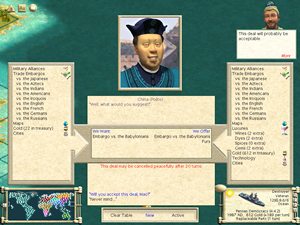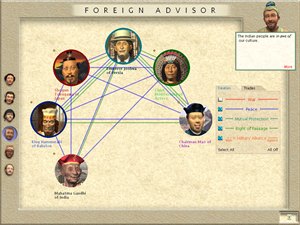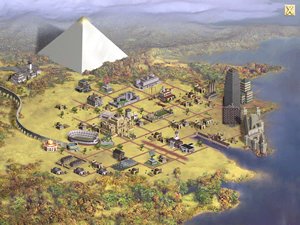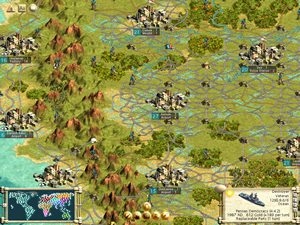Friends, Romans, Countrymen, lend me your PCs.
Sid Meier’s Civilization, in any of its incarnations, is an amazing accomplishment. Like Doom, Wizardry, or King’s Quest, the original game rests in the small pantheon of titles that revolutionized the medium and devoured millions of hours of gamers’ lives. Among the elite of PC game history, though, Civilization stands alone. With it, Sid Meier managed to create a game so versatile, so subtle, and so much fun that even the original is a blast to play today, despite dated graphics and a clunky interface.
Why bother to write a sequel then? Chess, after all, has managed to endure for centuries without anyone feeling the need to come up with "Chess III." With Civilization II still selling copies, what could Civilization III offer the gaming community (and in particular the vast sea of rabid fans)?
After an embarrassing number of hours playing Civ III, the answer is, "quite a lot." While keeping the core gameplay essentially intact, the Firaxis team has produced a genuinely new game that adds even more depth and flexibility to an already deep and flexible game. Veteran players will also be pleased to see the completely revamped interface. Depending on their strategies from previous versions, they will likewise be either happy or frustrated with the additional tweaks made to units, improvements, and wonders.
So much has changed, in fact, that players with thousands of hours of Civ I or II under their belts would be well advised to read the entire manual and the Readme file before playing. Feel free to dive right in (as a certain overeager, unnamed gaming journalist did right until he got his derriere handed to him by the Germans), but little clues like ‘settlers’ and ‘workers’ being different units, cities having to be connected to certain resources by roads to build the best units, and the inability to irrigate off ocean squares will very quickly remind most players that this is a new game.
The heart of the game is still building a mere village into a globe-spanning empire that will endure for all time. As in previous games, this is done through building new cities, researching new technologies, building improvements in your cities, defending against and attacking your neighbors, and establishing diplomatic relationships where beneficial. Keeping your people happy while keeping up with the competing civilizations remains the key challenge of the game.
Unlike in the first two incarnations, however, players will have a very hard time using the same cookie-cutter strategy every time they play. Dozens of innovations make this possible, but the most significant is that the maximum size of a player’s civilization is limited to 30-35 cities. Beyond that number, corruption becomes ridiculous. The resulting smaller empires mean trade and diplomacy are almost essential to survival, much less victory.
In addition, each civilization plays differently. Some civilizations are more inclined to war, others to research, and still others to trade. Although these characteristics can be turned off, civilization-specific units cannot, and the early-game impact of the Persian Immortals or the late-game devastation of the German Panzers cannot be overstated. The uniqueness of the different civilizations virtually guarantees that, even on the same map, each game plays differently.
 They’ve also made alternative victories much more viable. Although the first two games claimed to offer alternative paths to victory, the reality was that almost every game amounted to keeping the population happy enough to allow the player’s huge armies to conquer the world. That is certainly not the case in Civ III. It is actually possible for a relatively small civilization to take over rival cities (and win the entire game) by building a civilization that is far more culturally advanced than their neighbors.
They’ve also made alternative victories much more viable. Although the first two games claimed to offer alternative paths to victory, the reality was that almost every game amounted to keeping the population happy enough to allow the player’s huge armies to conquer the world. That is certainly not the case in Civ III. It is actually possible for a relatively small civilization to take over rival cities (and win the entire game) by building a civilization that is far more culturally advanced than their neighbors.
Just as culture has become more important, conquest is somewhat more difficult. Units face a movement penalty in enemy territory and city populations retain their nationality for centuries after they are captured (making them much more likely to overthrow your benevolent rule). These limitations, combined with the importance of culture and the robust diplomacy model, mean that even the most bloodthirsty Civ players will at least consider nonviolent strategies in certain situations.
Nevertheless, those who insist on swords over plowshares will not be disappointed by their options in Civilization III. Although the game is clearly about much more than combat, armchair generals will still have a wide variety of combined arms units available to send out to make the world safe for their despotic rule. Although veteran units are handled somewhat differently than in past games and barracks never (!) expire, combat will feel familiar to experienced players. Strong defensive units in all cities are essential, and mobility and attack strength will carry the day in offense.
Your ability to keep up with all the war, peace, diplomacy, happiness, construction, finances, and trade has been dramatically improved. The advisors’ reports provide a huge amount of information in a single place. They are also interactive, allowing you to zoom to trouble spots and make change quickly. Even leaders of the most sprawling empires should have no trouble maintaining a bird’s eye view of the status of their realm.
Espionage is the one exception to this. For some reason, despite its key role in the game, it gets neither its own advisor nor its own summary/management screen. Unlike diplomacy, espionage is managed from the map screen, which is the main interface for the game.
Like everything else in Civ III, the main map has been significantly improved to allow the player ready access to key information. Likewise, players can make important changes to cities and their units without having to switch to the "city" screen. This is an enormous time-saver and allows players to spend most of their time looking at the map.
 Fortunately, the map is easy on the eyes. As mentioned in the GR preview, the overall design elements are built around Pieter Bruegel’s Tower of Babel. The painting’s influence is particularly obvious in the city view, but the buildings and colors on the map are also clearly inspired by Bruegel’s work. In addition to being pretty, the map screen looks more realistic than any randomly generated land-masses in previous games by any publisher. The rest of the graphics in the game are also attractive, consistent with the design theme, and a significant improvement over past games.
Fortunately, the map is easy on the eyes. As mentioned in the GR preview, the overall design elements are built around Pieter Bruegel’s Tower of Babel. The painting’s influence is particularly obvious in the city view, but the buildings and colors on the map are also clearly inspired by Bruegel’s work. In addition to being pretty, the map screen looks more realistic than any randomly generated land-masses in previous games by any publisher. The rest of the graphics in the game are also attractive, consistent with the design theme, and a significant improvement over past games.
The other upgrades and improvements are too numerous to list. To name just a few: workers can now be automated to specific tasks; there is no need to build freight/caravan units; military units can be upgraded collectively; the "city view" screen and palace have returned, and city governors actually work (if you configure them properly).
Sadly, these changes come packaged with a few flaws. Most notable of these is the inability to turn on or off the massive corruption beyond 30-35 cities. For many players, the great joy of the Civ series is building a truly massive civilization and trying to keep it running. They should still have the option if they want it (although it is nice to play a game with no ridiculously large superpowers). There are also significantly smaller problems like happy citizens who look just like content ones, advisors who can’t remember the player’s name, and national boundaries that take far too long to become useful.
Although the nearly transparent interface works very well with practice, it is counter-intuitive at times. The inexcusable absence of a quick reference card for keyboard commands makes this particularly true. Likewise, longtime fans will be disappointed to know that the days of huge posters listing military units and technology advances are apparently a victim of increased production costs. The outstanding Civilopedia compensates well for this, but it’s still a noticeable absence.
With all that said, the minor improvements alone would still make Civilization III a must have for any strategy gamer. The game is still frighteningly addictive, constantly dangling new accomplishments in front of players who, at 3 am, are still planning on playing "just one more turn." Sid’s huge revision to the core gameplay, however, allows the game to finally reach the potential first hinted at by its predecessors. Players now have the opportunity to fully explore and experiment with the complex factors that make a nation great or forgettable. Civilization III offers a gameplay experience that, while fun and addictive, is also profound and thought provoking. It excels as a history lesson, as social commentary, an intellectual puzzle, and an infinitely replayable, highly enjoyable game.

-
Alternative victory options
-
Efficient, helpful interface
-
More addictive than heroin
-
Unlimited replayability
-
No more super, super powers











